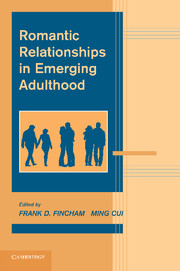Book contents
- Frontmatter
- Contents
- List of Contributors
- Foreword
- PART I INTRODUCTION
- PART II CONCEPTUAL AND METHODOLOGICAL FOUNDATIONS
- PART III THE DEVELOPMENTAL CONTEXT OF ROMANTIC RELATIONSHIPS IN EMERGING ADULTHOOD
- PART IV RELATIONSHIP PROCESSES IN EMERGING ADULTHOOD
- 9 The Evolution of Romantic Relationships: Adaptive Challenges and Relationship Cognition in Emerging Adulthood
- 10 Initiating and Evaluating Close Relationships: A Task Central to Emerging Adults
- 11 Putting the Romance Back Into Sex: Sexuality in Romantic Relationships
- 12 Understanding Romantic Relationships Among Emerging Adults: The Significant Roles of Cohabitation and Ambiguity
- 13 Implications of Parasympathetic Nervous System Functioning for Affect Regulation and Romantic Relationships in Emerging Adulthood
- PART V PRACTICAL IMPLICATIONS
- Index
- References
11 - Putting the Romance Back Into Sex: Sexuality in Romantic Relationships
Published online by Cambridge University Press: 06 December 2010
- Frontmatter
- Contents
- List of Contributors
- Foreword
- PART I INTRODUCTION
- PART II CONCEPTUAL AND METHODOLOGICAL FOUNDATIONS
- PART III THE DEVELOPMENTAL CONTEXT OF ROMANTIC RELATIONSHIPS IN EMERGING ADULTHOOD
- PART IV RELATIONSHIP PROCESSES IN EMERGING ADULTHOOD
- 9 The Evolution of Romantic Relationships: Adaptive Challenges and Relationship Cognition in Emerging Adulthood
- 10 Initiating and Evaluating Close Relationships: A Task Central to Emerging Adults
- 11 Putting the Romance Back Into Sex: Sexuality in Romantic Relationships
- 12 Understanding Romantic Relationships Among Emerging Adults: The Significant Roles of Cohabitation and Ambiguity
- 13 Implications of Parasympathetic Nervous System Functioning for Affect Regulation and Romantic Relationships in Emerging Adulthood
- PART V PRACTICAL IMPLICATIONS
- Index
- References
Summary
Recent media attention on romantic relationships and sexual behavior in emerging adulthood has portrayed hooking up as a primary means of sexual interaction among young people. Popular books on adolescent and emerging adult sexuality include titles such as Hooking Up: Sex, Dating, and Relationships on College Campuses (Bogle, 2008) and Unhooked: How Young Women Pursue Sex, Delay Love, and Lose at Both (Stepp, 2007); recent articles in the New York Times include scintillating titles like “The Demise of Dating” (Blow, 2008) and “Friends with Benefits, and Stress Too” (Carey, 2007). Popular media frequently portray emerging adults similarly, whether through movies like American Pie 2 or “reality” television like MTV's The Real World. However, as we describe later, these portrayals do not capture the reality of emerging adults' experiences, only presenting a small piece of a very complex picture.
THEORIES OF SEXUALITY
Mirroring limitations in the media, theories of sexuality do not adequately address emerging adults' sexual behaviors within romantic relationships. Theories about sex tend to fall into four categories. First, biological theories focus on pubertal development and hormonal activation and therefore are more relevant for adolescents than for emerging adults (Rodgers & Rowe, 1993; Udry, Billy, Morris, Gruff, & Raj, 1985). Second, problem behavior theories describe adolescent sexual behaviors within a constellation of other problem behaviors that share antecedents (e.g., Jessor & Jessor, 1975; Newcomb, Huba, & Bentler, 1986). Emerging adults obviously engage in some sexual behaviors with potentially negative physical or psychological consequences.
- Type
- Chapter
- Information
- Romantic Relationships in Emerging Adulthood , pp. 213 - 233Publisher: Cambridge University PressPrint publication year: 2010
References
- 6
- Cited by



